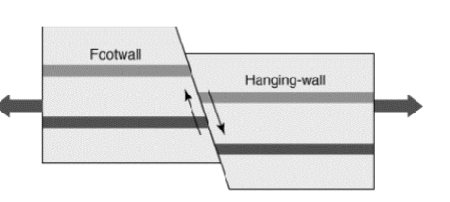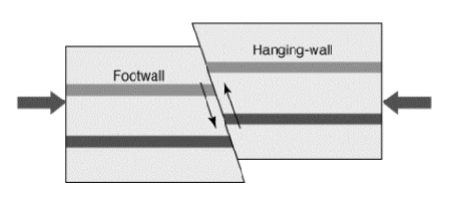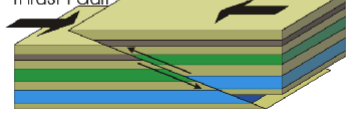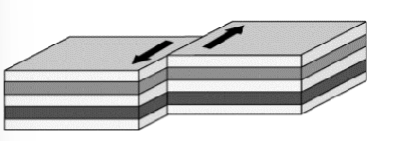Earthquakes and Tsunamis
1/30
There's no tags or description
Looks like no tags are added yet.
Name | Mastery | Learn | Test | Matching | Spaced |
|---|
No study sessions yet.
31 Terms
fault
structure resulting from brittle deformation when different kinds of stress are applied → identified by hanging (head) & wall/foot wall and relative motion
normal faulting
type of faulting when hanging/head drops relative to footwall (result of tensile stress)

reverse faulting
type of faulting when hanging/head wall moves up relative to footwall (result of compressive stress)

thrust faulting
type of faulting when essentially a reverse fault at an angle, (result of shear stress)

strike-slip faulting
type of faulting that is nearly vertical, (result of shear stress) → either right-lateral or left-lateral (stand on one side of the fault and look across it, the opposite side appears to move a certain direction)

earthquake
sudden shaking of Earth's surface caused by the release of built-up energy of tectonic forces along a fault. released when stress overcomes friction, allowing the fault to slip.
elastic strain
explains how energy is stored → Earth's crust is constantly subjected to forces due to tectonic plate movements. Rocks on a fault experience stress, temporarily bending and deforming elastically instead of breaking
elastic rebound
stress exceeds the rock’s strength, the fault ruptures, and the stored elastic energy is released. rocks snap back to their original shape but in a new position. displacement occurs as released energy travels in seismic waves, causing ground shakes.
displacement
ground shifts along the fault after elastic rebound, which can be a few centimeters or several meters.
aftershocks
when surrounding crust readjusts to the new stress conditions after earthquake, smaller earthquakes in the same region that decrease in frequency and intensity over time
body waves
type of seismic waves consisting of P-waves and S-waves that travel internally in Earth, damaging but does not break buildings
surface waves
type of seismic waves consisting of Love and Rayleigh waves that travel on Earth’s surface → shaking and rolling waves that cause most earthquake damages
P-waves
type of body wave → particle motion and wave propagation are parallel, going in the same direction (compression in slinky)
S-waves
type of body wave → particle motion and wave propagation are perpendicular to each other, vertical motion but wave propagation is horizontal (snapping a rope tied to door)
Love waves
type of surface wave → propagate back and forth/side to side on surface
Rayleigh waves
type of surface wave → rolling waves across the surface
Recording seismic waves
See arrival of waves on seismometer → P (primary) waves arrive first, S (secondary) waves arrive second → time difference helps calculate the distance from the seismometer to the earthquake.
Triangulation
how to find the location of an earthquake → three seismometers knowing velocity and time of waves can inform distance and record the intersection of three circles of possible locations (epicenter)
Mercalli Intensity Scale
measures the size of an earthquake based on its effects on people, buildings, and the Earth's surface, qualitative, I to X
Richter Magnitude Scale
measures the size of an earthquake related to the maximum amplitude of the S wave from the seismogram → uses logarithims where M7 earthquake is 10x large than M6 → saturates after M7 due to seismic waves being too large
moment magnitude scale
related to the size of earthquake rupture area/fault plane, based on energy release, does not saturate like Richter Magnitude Scale
Ring of Fire
Rim of pacific ocean, where largest earthquakes occur
interplate earthquake
type of earthquake occurring at the boundary between tectonic plates
intraplate earthquake
type of earthquake occurring within the interior of a tectonic plate
shaking, landslides, liquefaction (solid starts behaving like a liquid), fire, disease, tsunamis
Causes of Earthquake damage
earthquake forecasting
scientists can forecast likelihood of an earthquake in a specific area over time → predicts number of times per century shaking from earthquakes will exceed 0.20g (significant damage to older buildings)
mid-ocean ridges
seismicity occurs at shallow depths, small earthquakes
convergent boundaries
seismicity occurs at deep depths, large earthquakes due to subduction and compression
transform boundaries
seismicity occurs at shallow to intermediate earthquakes due to shear forces
tsunamis
large wave produced by displacement of the sea floor; the displacement can be due to an earthquake, submarine landslide, or volcanic eruption
poor construction, mining, fracking, wastewater disposal
How Humans Affect Earthquake Consequences